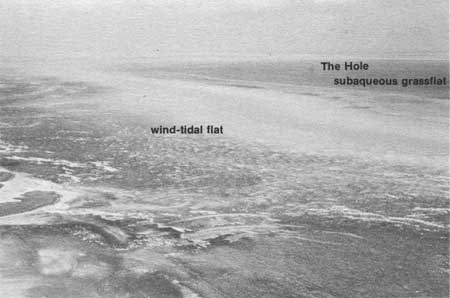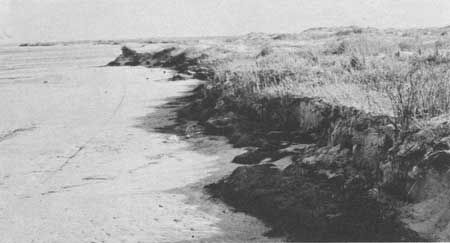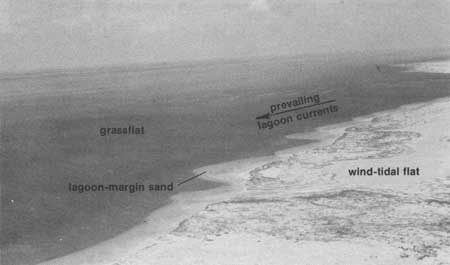
|
Texas Bureau of Economic Geology
Padre Island National Seashore: A Guide to the Geology, Natural Environments, and History of a Texas Barrier Island |
ENVIRONMENTS OF PADRE ISLAND AND LAGUNA MADRE
(continued)
LAGOON SYSTEM
Environments of the lagoon system mapped on plate I are wind-tidal flats, lagoon sand and shell berms, subaqueous lagoon-margin sand, grassflats, lagoon-center sand, and serpulid reefs. These are natural aquatic environments of Laguna Madre that, except for two islands made of sand and shell berms (North and South Bird Islands), either remain subaqueous at all times or are flooded by wind tides as well as storm tides.
Wind-Tidal Flat (L1, L2, L3)
Extensive barren flats on the periphery of Laguna Madre that are subject to flooding by wind tides are called wind-tidal flats. In the Land-Cut Area of Laguna Madre (Central Section, pl. I), wind-tidal flats occupy the entire lagoon. These vast flats are broken by the Gulf Intracoastal Waterway, which is presently the only constant link between waters of northern Laguna Madre and those of southern Laguna Madre.
Wind-tidal flats are generally less than 3 feet above mean sea level. Because the flats lie so low and have an extremely gentle slope, lagoon water pushed by strong winds can quickly flood large areas of the flats. The frequency of inundation, controlled primarily by slight differences in elevation, determines the types of wind-tidal flats that will develop in an area. Within the map area of plate I, three main types are recognized: (1) flats with loose windblown sand forming small dunes (L1), (2) flats with finer sand and mud (L2), and (3) flats covered with extensive algal mats (L3). There are, however, many variations and transitional types.
The highest wind-tidal flats (L1 unit), which are rarely flooded, are in the Land-Cut Area. The sand there dries for long periods between high wind tides and remains loose enough to be blown into small dunes that migrate rapidly across the flats (pl. I, L1 photograph). In most places there is not sufficient loose sand to cover the flat completely, however, and the dunes migrate over the firm, wet sand or over local algal mats developed in depressed, moist areas. The windblown sand in the small dunes is fine and well sorted. Thin clay layers may be deposited on these tidal flats during the rare tidal inundations.
On wind-tidal flats that are flooded more frequently (L2 unit), the sand and clay substrate (fig. 92) remains relatively firm. Consequently, there is not enough dry, loose sand available to form dunes (pl. I, L2 photograph). Algal mats occur locally but are very thin and not as prominent as those in environments labeled L3. This intermediate wind-tidal flat occurs throughout the map area but is most common in the southern part of the Seashore. The wind-tidal flats with firm sand (L2) characteristically occupy (1) tidal-flat areas within the lagoonward fringes of the back-island area, and (2) tidal environments that are submerged too frequently for the development of extensive algal mats.

|
| Figure 92. Trench dug on a wind-tidal flat, showing the alternating layers of sand (light layers) and clay (dark layers). Most of the sand is carried to and deposited on the flats by the wind. Thin clay layers are deposited as clay settles from water flooding the flat during high tides. The pen (about 6 inches long) serves as a scale for the vertical face of the trench. |
Extensive algal mats develop on flats that are alternately emergent and submergent in fairly regular cycles. In aerial photographs and on the ground these algal flats appear as very dark areas surrounding the lagoon (fig. 93). Sand is blown onto the algal flat from the barrier island, and with each tidal inundation, thin layers of clay are deposited from suspension. The algal mats that develop on the moist surface commonly break up and peel from the underlying sand and clay during drier periods between tidal floods (pl. I, L3 photograph).

|
| Figure 93. Wind-tidal flat covered by extensive algal mats (pl. I, grid N-10). View is to the southwest. In aerial photographs such as this, the algal flats always appear as dark-gray zones, whereas the wind-tidal flats covered by firm sand are a very light color. |
Bladelike crystals and rosettes (clusters of crystals resembling a rose, figs. 94a and 94b) composed of the mineral gypsum (calcium sulfate) have been found in the sediments of wind-tidal flats in the Land-Cut Area on both sides of the Intracoastal Waterway. Gypsum rosettes have also been reported in the dredged spoil along Mansfield Channel. Masson (1955) postulated that the crystals are formed by waters of high salinity that periodically flood the wind-tidal flats. As the mineral-laden waters seep into the underlying sediments, gypsum is precipitated, forming the crystals, which grow larger with successive periods of infiltration and precipitation.

|
| Figure 94(a) and (b). Gypsum rosettes. The smaller rosettes, in photograph (a), are composed of transparent to translucent crystals with relatively smooth crystal faces. The crystals composing the large rosette in photograph (b) are gray; its crystal faces have a grainy, sandpaperlike texture produced as the crystals grew larger and incorporated sand from the surrounding sediments. |
Lagoon Sand and Shell Berms (L4)
Within Laguna Madre in the northern part of the National Seashore are two natural islands, North Bird Island (grid W-3, pl. I) and South Bird Island (grid U-2). These islands are composed of sand and shell that were deposited on shoals by breaking storm waves generated within the lagoon. As more and more sediment was added to the islands in the form of beaches and spits, series of berms and interlying low areas, or swales, were created, giving the islands the characteristic topography seen today (figs. 95 and 96). The old spits and beach ridges, or berms, have become vegetated, but the swales between remain barren and are usually partly submerged. On plate I most of the swales were mapped as subaqueous lagoon-margin sand (L5).

|
| Figure 95. South Bird Island, a natural island in Laguna Madre (pl. I, grid U-2). View is to the north. The island is a series of sand and shell berms (ridges), built by storm waves on a shoal. The ridges have become vegetated, but the intervening low areas, or swales, remain barren and are often flooded. |

|
| Figure 96. North Bird Island (pl. I, grid W-3). View is to the north. Although not as distinct, a ridge-and-swale structure like that of South Bird (fig. 95) is apparent on North Bird Island. Both islands are important nesting grounds for a variety of birds. |
Islands in Laguna Madre are popular nesting grounds for a variety of bird species. The importance of protecting these rookeries has been recognized, and North and South Bird Islands have now been designated as wildlife sanctuaries. Boat landing and hunting on the islands are prohibited by Federal and State laws.
Lagoon-Margin Sand (L5)
In the northern part of Laguna Madre, where large wind-tidal flats are absent, a narrow band of sand (L5) occurs along the relatively high-energy lagoon margin. This sand is constantly reworked by waves and currents (pl. I, L5 photograph). Although the higher parts of this strip of sand, which could be considered in part a lagoonal beach, are occasionally above water, much of this lagoon-margin environment is usually submerged (up to 3 feet). Lagoonal waves and currents form ripples and large sand waves on the surface of the shallow bars (figs. 97 and 98). Large sand waves seen on aerial photographs were the primary criterion used to distinguish the lagoon-margin sand from wind-tidal flats.

|
| Figure 97. Lagoon-margin sand (pl. I, grid N-2). View is to the southwest. |

|
| Figure 98. Large sand waves and ripples on lagoon-margin sand exposed during very low tide. View is to the southwest. |
During very high wind tides, water may be driven over the lagoon-margin sand and lap onto back-island environments, eroding small cliffs at the edges of the barrier flats (fig. 99). At very low tides, almost all of the lagoon-margin sand may be exposed (fig. 98).

|
| Figure 99. Small cliff at the edge of the barrier flat, eroded by high wind and storm tides. View is to the northeast. |
Lagoon-margin sand is carried into the lagoon either by wind eroding back-island dunes or by waters eroding small channels on the wind-tidal flats. The subaqueous sand forms lobes deflected toward the south in the direction of dominant currents along the island shoreline in northern Laguna Madre (pl. I and fig. 100). The sand lobes are generally less than 300 feet wide but are constantly reshaped by shoreline processes. Other areas mapped as lagoon-margin sand (pl. I) include a shoal area near the shoreline in grid X-3 and the unvegetated subaqueous fringes and swales of North and South Bird Islands (grids W-3 and U-2).

|
| Figure 100. Lobes of lagoon-margin sand oriented southward (bottom left), in the direction of prevailing lagoonal currents. |
Grassflat (L6)
In shallow, quiet areas of the lagoon, away from the high-energy shorelines, are broad, subaqueous flats upon which thrive marine grasses and a variety of invertebrates. As shown on plate I, grassflats occur in all sections of Laguna Madre. The largest and densest grassflats occur in the northernmost part of the Seashore and in the central part between Middle Ground (U-9) and The Hole. The grassflat environment can be identified by its dark, mottled texture on aerial photographs (fig. 101).

|
| Figure 101. Subaqueous grassflat in Laguna Madre (pl. I, grids O-9 and R-9). View is to the southwest; for scale, the diameter of the spoil heap is about 200 feet. The grassflats are environments of high biologic productivity, serving as homes, spawning grounds, or nurseries for many fish and invertebrates. |
The grassflats (L6) generally are covered by less than 4 feet of water, and the shallowest parts commonly are exposed at the lowest tides (fig. 102). The water depth, as well as the salinity and turbidity, determines the types of grasses that grow on the muddy sand and shell bottom. Shoalgrass (Halodule wrightii), the dominant marine grass in Laguna Madre, can tolerate the highest salinity and turbidity and prefers the shallower depths (Brown and others, 1977). It is usually shoalgrass that can be seen washed onto the lagoon shore or tidal flats, where it dries in carpet-like mats and bleaches a brilliant white in the sun (figs. 103 and 104).

|
| Figure 102. Lagoon grassflat exposed during low tide (pl. I, grid P-8). View is to the south. Distance from viewer to the spoil heap is approximately 700 feet. |

|
| Figure 103. Dead shoalgrass that has been washed onto a wind-tidal flat, dried in mats, and bleached white by the sun. |

|
| Figure 104. Rows of bleached shoalgrass marking varying tide levels on the wind-tidal flats and reworked spoil (pl. I, grid Q-8). View is to the south. |
Other grasses growing on lagoonal grassflats are widgeon-grass (Ruppia maritima), turtlegrass (Thalassia testudinum), clovergrass (Halophila engelmannii), and manateegrass (Cymodocea manatorium). Manateegrass and widgeongrass are generally restricted to southern Laguna Madre, where salinities are commonly lower than those of the lagoon north of the Land-Cut Area. In addition to the marine grasses, algae such as the leafy, calcareous alga Acetabularia, are common in shoal areas such as Middle Ground (pl. I and fig. 105).

|
| Figure 105. Middle Ground, an area of wind-tidal flats and shallow grassflats (pl. I, grids U-9 and U-10). View is to the north. |
Grassflats support a large in vertebrate population, predominantly a variety of snails and clams. The grassflats are spawning grounds or nurseries for many fish and for crustaceans such as shrimp and crabs. This environment of high biologic productivity, which is important in the coastal ecosystem and to the Gulf fishing industry, is maintained by a delicate balance of salinity, turbidity, and water depth (Brown and others, 1977).
Lagoon-Center Sand (L7)
Like the grassflats, lagoon-center sand (fig. 106) occupies broad areas of the lagoon. Most of the lagoon-center sand is located south of the Land-Cut Area, although some occupies the southern part of The Hole and the area north of Middle Ground to grid K-1 (pl. I). Although locally sparse marine grass grows on this lagoon-center sand, the environment can be easily distinguished from grassflats on aerial photographs by its light color and smooth photographic texture.

|
| Figure 106. Muddy sand on the center bottom of Laguna Madre, just south of the Land-Cut Area (pl. I, grid S-13). View is to the northwest. |
Sand in this environment is generally muddy. Mud is concentrated in the deepest, quietest parts of the lagoon where depths are about 8 feet, the greatest depths occurring within the map area of plate I. Substrates of deeper lagoon environments outside the map area are composed almost entirely of mud.
Serpulid Reefs (L8)
Serpulid patch reefs and associated interreef environments of shell, sand, and mud occur locally near the mouth of Baffin Bay (fig. 1 and pl. I, grids G-1 and H-1). The reefs are constructed of serpulid (annelid) worm tubes composed of calcium carbonate. The L8 photograph on plate I shows a 6-inch sample of the serpulid reef rock oriented so that the top is toward the viewer. The marine worms that secreted the tubes were attached to the underlying substrate.
Living annelid worms have not been observed in the reefs, and the reefs are considered dead (Andrews, 1964). Although the reefs are no longer growing, the hard worm tubes remain resistant to attack by waves and are dangerous to boaters unaware of their locations. The tops of the reefs are commonly at the water surface or are exposed during low tides; water depths around the reefs are generally 2 to 3 feet (Andrews, 1964). The Gulf Intracoastal Waterway is cut through the serpulid reefs in grids G-1 and H-1, and boats straying beyond the boundaries of the Waterway in that area are likely to run aground on the reef rock.
The reefs in the map area occur as isolated patches. The patch reefs range from small, circular reefs 25 feet in diameter to larger, ellipsoidal ones up to 130 feet long (Andrews, 1964). Although the serpulid patch reefs and the interreef environments cover only a very small part of the map area of plate I, broader fields of serpulid reef rock are found in Baffin Bay to the west of Laguna Madre (fig. 1).
| <<< Previous | <<< Contents >>> | Next >>> |
state/tx/1980-17/sec4a.htm
Last Updated: 28-Mar-2007